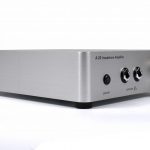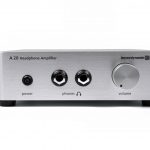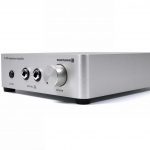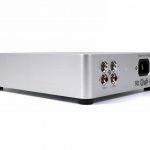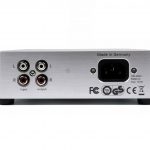Introduction, Unboxing and Scope of Delivery
 The Beyerdynamic A20 is the little brother of the A2, but the target group and functional orientation are fundamentally different. The A20 cannot and does not want to cover many things at all, but presents itself as a very independent and at the same time solid device, whose minimalism is really barren to the hila. You want a real headphone amplifier, powerful, honest and without firlefanz? Please, there would be one.
The Beyerdynamic A20 is the little brother of the A2, but the target group and functional orientation are fundamentally different. The A20 cannot and does not want to cover many things at all, but presents itself as a very independent and at the same time solid device, whose minimalism is really barren to the hila. You want a real headphone amplifier, powerful, honest and without firlefanz? Please, there would be one.
But at the latest when it comes to the question of connecting digital signal sources, there would be an early divorce again, because with such subtleties the A20 has been living in the strictest separation of goods since birth. If you are looking for something like this, you have to look at other models that also exist like sand by the sea. If you don't like the A2, because you find the price a bit too plump, you can take a look at the Impacto. That, in turn, would be such a thing with a decent DAC (Sabre 9018Q2C) and even usable on the go.
The whole box already weighs heavily and one already suspects that you will probably get something really well shielded after the leaching. Sand will probably not have been used, concrete actually not. In the neat box you will find besides the amplifier two different connection cables, reading material and a little German air.
This makes perfect sense when you think of German and American sockets. Which would also make it clear that, unlike the A2, the A20 has a full-range power supply of 110 to 230 volts of mains voltage. In Italy, however, there would already be problems with the cables, and in France and Eastern Europe, by the way, they would also have problems.
Optics, haptics and functionality
The Beyerdynamic A20 is a real heavyweight. With its 1640 grams, it even weighs a tick more than the Sapphire RX Vega 64 Nitro+, but is even cheaper. Thus, at least for the time being, the weight/price ratio is correct. And otherwise? The manufacturer relies on a brushed, solid aluminium unibody without seams. The lid and bottom plate made of steel are screwed together and, thanks to good gap dimensions to the body, offer no visual reason to complain. With the A20, one relies on a purely analog amplifier as a terminal device and emphasizes this simplicity even in the timeless design language. Corners and edges? There are at least visually none.
The front carries the electric on/off switch, which also serves as a status indicator. However, there is generally no switch with real power disconnection. This keeps the device in continuous standby, but this doesn't really bother with the almost 0.4 watts. The two parallel connected 6.3 mm jacks for the headphone outputs are, like the input area, soldered firmly with the board, a separate wiring has been spared, thank God. The solid aluminium button on the rather precise volume pot is haptically a pleasure and visually an eye-catcher.
The back bears the cold device jack for the mains connection on the right side and thankfully the otherwise gladly taken Mickey Mouse jack has been dispensed with. This allows you to use the commercially available angle plugs as a substitute, in case there are space problems at the back. The entrance consists solely of a pair of RCA beech for the two stereo channels and another pair as an output if you want to use the A20 for direct looping through. A test with a good old turntable has delivered a much better result than the long detour via the full amplifier and back to the A20. The shorter the signal path, the better!
The underside is no longer quite so photogenic, but the steel plate used is still galvanized. The very massive sheet metal, like the steel and painted lid of the same thickness, creates a good magnetic shielding and you can put the A20 well and gladly on other technology. Even amplifiers with a powerful M- or toroidal transformer do not manage to transport your magnetic field to the inside of the A20. On the baroque floor sheet, Stuss is simply over. With the rubber feet, I can only advise everyone to wipe it all off with a lot of spirit and, if necessary, to stick some fleece, because they easily stain something when fresh. However, I have already discussed this with the manufacturer. Silicone feet, by the way, also went.
The following gallery provides a good all-round view of the somewhat pummelling and weighty aluminium unibody of the Beyerdynamic A20:
Before I start the screwdriver with the hexagon, here again the data sheet with all important information in PDF form:
Datenblatt A20


















